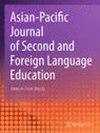基于场景的课堂情境模式:重塑非母语教师的决策与教学推理
IF 2.2
Q2 EDUCATION & EDUCATIONAL RESEARCH
Asian-Pacific Journal of Second and Foreign Language Education
Pub Date : 2023-10-08
DOI:10.1186/s40862-023-00208-2
引用次数: 0
摘要
在过去的二十年里,教师决策和教学推理得到了广泛的研究。然而,在一项研究中同时检验这两种结构的研究很少。本研究试图通过使用教师谈话自我评价(SETT)框架实施教师教育课程来解决这一差距,该课程旨在重塑10名非母语教师的决策和教学推理。数据是通过Camtasia在10周的时间里收集的,Camtasia促进了视频刺激的回忆。采用会话分析的方法,分析了学习者与初任教师、初任教师与初任研究者或初任教师在课堂语境中的互动。研究结果表明,在教师教育课程(POST-TEC)后,新手依赖于以set为导向的元语言来证明他们的决定。此外,尽管在PRE-TEC阶段,面对学习者的沉默,他们会因为沮丧而发脾气和语码转换,但在POST-TEC阶段,他们在讨论中使用了许多有用的互动决策,如避免老师的呼应和现场纠正。可以得出的结论是,单独研究SETT模式有助于我们更丰富地理解课堂话语,因为每种模式都有自己特定的教学目标,教师在课堂决策中应该注意这些目标。本文提出了进一步研究的建议,并对语言教师的决策和教学推理更加明确提供了启示。本文章由计算机程序翻译,如有差异,请以英文原文为准。
Scenario-based classroom context mode: reshaping non-native teachers’ decision-making and pedagogical reasoning
Abstract Teacher decision-making and pedagogical reasoning have been extensively investigated in the last two decades. However, there is a scarcity of research that examines the two constructs together in one single study. This study was an attempt to address this gap by implementing a teacher education course using the self-evaluation of teacher talk (SETT) framework that aimed to reshape the decision-making and pedagogical reasoning of ten non-native teachers. Data were collected over a 10-week period through Camtasia, which facilitated video-stimulated recall sessions. Conversation analysis was employed to analyze the interactions in classroom context between the learners and the novice teachers and the interactions between the novices and the first researcher-as-a-participant or experienced teacher. The findings showed that the novices relied on the SETT-oriented metalanguage to justify their decisions after the teacher education course (POST-TEC). In addition, although in the PRE-TEC phase, they lost their temper and codeswitched because of frustration when facing learners’ reticence, they used a number of useful interactive decisions such as avoiding teacher echoes and on-the-spot corrections during discussions in the POST-TEC. It can be concluded that examining the SETT modes separately contributes to our richer understanding of classroom discourse, as each mode has its own specific pedagogic goals that teachers should pay attention to in their classroom decisions. Suggestions for further research and implications for making the decision-making and pedagogical reasoning of language teachers more explicit are provided.
求助全文
通过发布文献求助,成功后即可免费获取论文全文。
去求助
来源期刊

Asian-Pacific Journal of Second and Foreign Language Education
Arts and Humanities-Language and Linguistics
CiteScore
2.90
自引率
5.60%
发文量
40
审稿时长
5 weeks
 求助内容:
求助内容: 应助结果提醒方式:
应助结果提醒方式:


